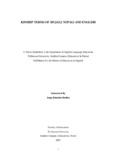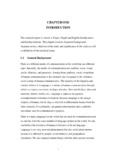Please use this identifier to cite or link to this item:
https://elibrary.tucl.edu.np/handle/123456789/505| Title: | Kinship Terms of Sinjali, Nepali and English |
| Authors: | Budha, Jang Bahadur |
| Keywords: | English language;Nepali language;Sanjali language;Teaching language |
| Issue Date: | 2010 |
| Publisher: | Faculty of English Education |
| Institute Name: | Surkhet Campus, Birendranagar |
| Level: | Masters |
| Abstract: | A family relationship through blood and marriage is kinship relation. The kinship systems are the major areas of anthropological study for anthropologists. In fact, kinship relation is one of the main organizing principles of human society. In the present study ''Kinship terms of the Sinjali, Nepali and English", the researcher has presented different kinship relations and corresponding terms to refer to the relations. The main objectives of this study were to determine Sinjali kinship terms, and to compare and contrast those terms with Nepali and English kinship terms and to point out some pedagogical implications. To fulfill those objectives, the researcher collected data from Sinjali speakers of Sinja territory for Sinjali kinship terms by using a set of questionnaire and English kinship terms and Nepali kinship terms were taken from secondary source Rai (2001). The total sampling population was eighty eight respondents of Sinjali dialect. (44 males and 44 females). Eight Sinjali speakers from each VDC. (Viz: Bumra Mādichaur, Mālikā Botā, Kanakā Sundary, Birāt, Pāndawagufā, Dhānpā, Narākot, Sanigāun, Badki, Kālikā khetu and Māhābai Pātarkholā). The data were collected by the help of a pre-set questionnaire and inter-view using snow ball non-random sampling procedure. The researcher also consulted different books, articles and previous theses for the secondary source of data. The major findings of the present study shows that the Sinjali is the richer than both the Nepali and English language in the term of kinship terms. The system of Nepali and Sinjali kinship terms and English kinship terms have the relationship of mono Sinjali vs multi Nepali, mono English vs multi- Sinjali and mono Sinjali vs multi English. In addition to this, there are differences between/ x among one to one correspondence relationship of the appellative forms to signify the same relation of the particular languages. The present thesis has four chapters which are introduction, methodology, analysis and interpretation, and finding and recommendations. Each chapter has been divided into various sub-chapters. The first chapter deals with general background, literature review, objectives of the study, significance of the study and definition of technical terms. Similarly, the second chapter includes the methodology of research works. It is subdivided into source of data, research tools, sampling population and sampling procedure, process of data collection and limitations of the study. Like wise, the third chapter consists of analysis and interpretation of the data, which is the main part of the thesis. The comparison has been made specially between/among Sinjali, Nepali and English kinship terms for appellative use and addressive use. Finally, chapter four of this thesis deals with the findings and recommendations based on the analysis and interpretation of the data which are valuable for teaching language |
| URI: | http://elibrary.tucl.edu.np/handle/123456789/505 |
| Appears in Collections: | English Language Education |
Files in This Item:
| File | Description | Size | Format | |
|---|---|---|---|---|
| cover.pdf | 57.41 kB | Adobe PDF |  View/Open | |
| CHAPTER.pdf | 843.78 kB | Adobe PDF |  View/Open |
Items in DSpace are protected by copyright, with all rights reserved, unless otherwise indicated.
